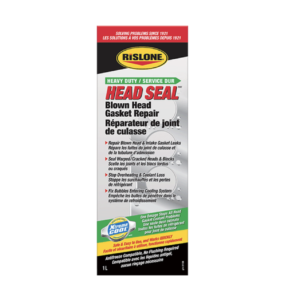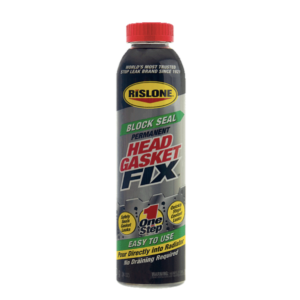- Permanently Fixes Cooling System Leaks
- Antifreeze Compatible – No Draining Required
- One Step – Pour Directly Into Radiator – Easy To Use
What does it do? Our formula permanently repairs larger leaks in radiators, intake manifolds and gaskets, heater cores, blocks, heads and freeze plugs. It contains an antifreeze-compatible sodium silicate liquid glass formula, so no draining of the cooling system is required. Not to mention, it will not harm the cooling system when used properly. The intake gasket seal you’ve been looking for is far more effective, easy to use, and less expensive than you’ve ever imagined. This is why Rislone exists: to offer usable, low-cost intake gasket seal and other products to auto owners who have no special experience or expertise. We’ve been doing this for over 70 years, so we know a thing or two about chemical repairs.
- Part Number: 41108
- Dosage: One bottle treats cooling systems from 8 liters to 15 liters. Use 1/2 bottle for cooling systems from 5 liters to 7.9 liters. For larger systems use one bottle for every 15 liters of cooling system capacity.
- Size: 383 g
Additional Information
Rislone® Liquid Copper™ Block Seal Intake & Radiator Stop Leak seals larger leaks regular stop leaks won’t. One step formula permanently repairs coolant loss problems on cars, trucks, ute’s, vans, SUV’s and RV’s. Antifreeze compatible sodium silicate liquid glass penetrates large and small leaks in plastic, aluminum and cast iron heads, blocks, intake manifold & gaskets, freeze plugs, heater cores and radiators. Fiber additives lock together with liquid to increase strength and promote a permanent seal. It will not harm the cooling system when used properly, no draining is required. Use with ALL types of traditional or extended life coolant including yellow, orange, pink, red, blue, purple and green silicate based &
non-silicate based (OAT/HOAT) 50-50 mix antifreeze, and/or water.
- World’s Most Trusted Stop Leak Brand Since 1921
- Permanently Fixes Cooling System Leaks
- Antifreeze Compatible—No Draining Required
- One Step—Pour Directly Into Radiator—Easy To Use
ASTM D3147 LABORATORY TEST
Standard Test Method for Testing Stop-Leak Additives for Engine Coolants.
This test method covers screening procedures for the preliminary evaluation of leak-stopping materials intended for use in engine cooling systems. The results of this test show that a 0.64 mm round hole and a 0.13 mm wide slot can be successfully sealed with this product.
DANGER: Opening the cooling system while the engine is hot or running may cause severe burns.
NOTE: Cooling systems that are dirty or partially clogged should be flushed before usage. This product is designed to be used with the manufacture’s recommended antifreeze/water mixture.
Protect from freezing.
INSTRUCTIONS:
- Allow engine to cool. Make sure engine is cool enough so radiator cap can be safely removed.
- Shake well. Pour Rislone Liquid Copper directly into radiator. TIP: If direct access to radiator is not available and if overflow tank is pressurized, you can install in tank.
- Fill radiator and overflow tank to proper level and reinstall radiator cap.
- Turn heater on hot and fan on high.
- Start vehicle and idle engine for 15 minutes.
- Turn vehicle off and allow engine to cool. Top off (fill up) radiator and leave Rislone Liquid Copper in cooling system for continued protection. Drive vehicle as normal. For severe leaks, like a blown head gasket, it is recommended to use Rislone Head Gasket Fix.
DOSAGE:
One bottle treats cooling systems from 8 liters to 15 liters. Use 1/2 bottle for cooling systems from 5 liters to 7.9 liters. For larger systems use one bottle for every 15 liters of cooling system capacity. Small engines or other small systems use approximately 25 mL per liter of fluid capacity.
PURPOSE OF A COOLING SYSTEM
Your engine creates up to 2750 degrees C of heat within the combustion chamber. Enough heat to melt the entire engine in less than 30 minutes! Approximately 1/3 of fuel’s energy is converted into usable power to propel the vehicle, 1/3 of the energy is dissipated out through the exhaust system, and the remaining 1/3 is carried off by the cooling system.
HOW DOES A COOLING SYSTEM WORK?
Coolant, which is a mixture of water and ethylene glycol (Antifreeze), is pumped throughout the engines water jacket drawing heat from the head, pistons, combustion chambers, cylinder walls, valves, etc. The heated coolant travels from the water jacket through a radiator hose, to the radiator, where aided by a fan, its air cooled and returned via the other radiator hose to the engine. Gas is SAVED and engine life INCREASED when the cooling system quickly reaches and maintains a very narrow operational range regardless of outside temperature extremes or engine load demands. Upon engine start up, the
temperature must rise quickly, and then remain balanced – not too hot and not too cold! It’s important to understand how the condition of the coolant and the condition of the cooling system components can affect the operational economy and life of your engine!



